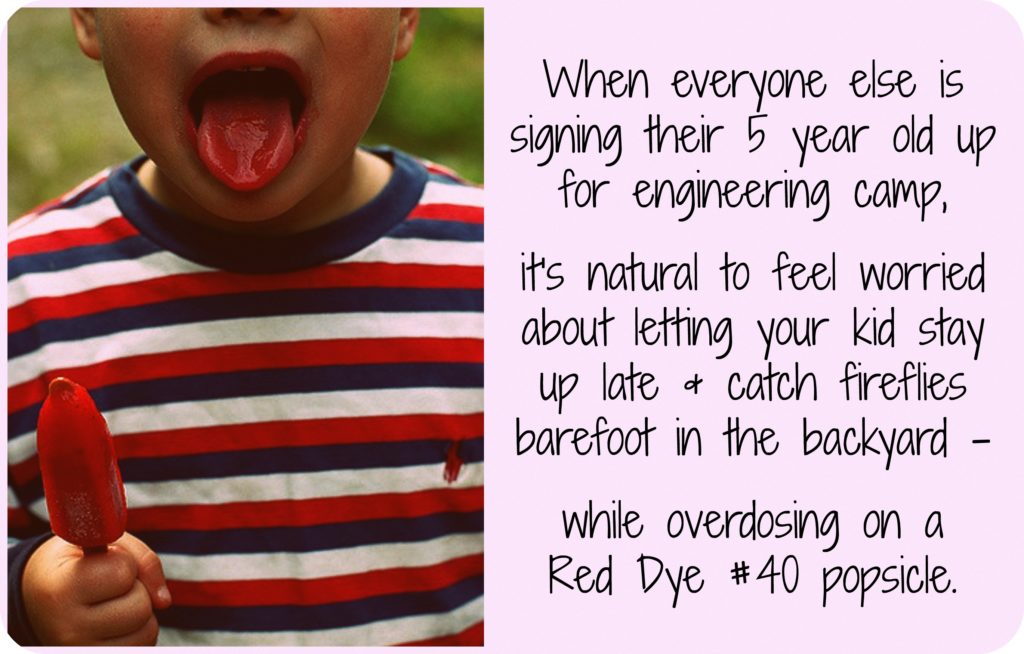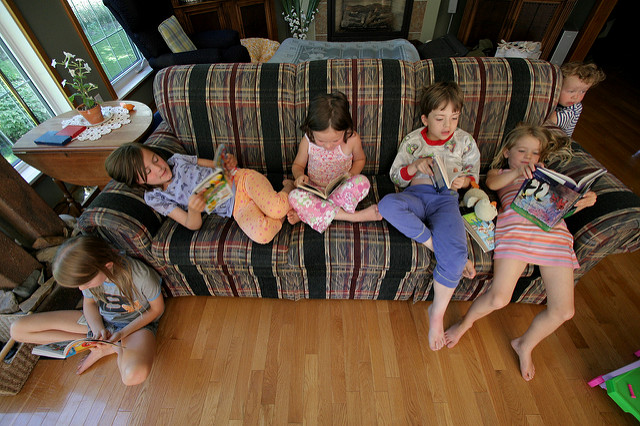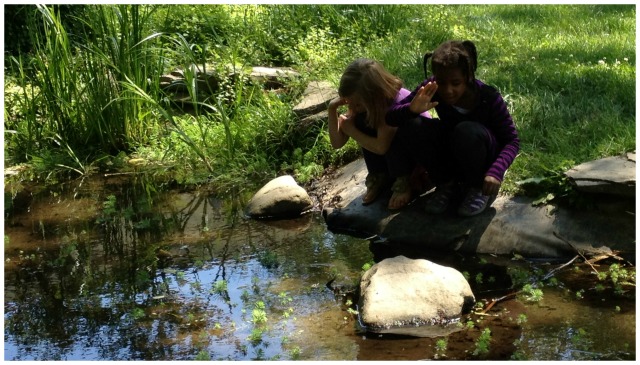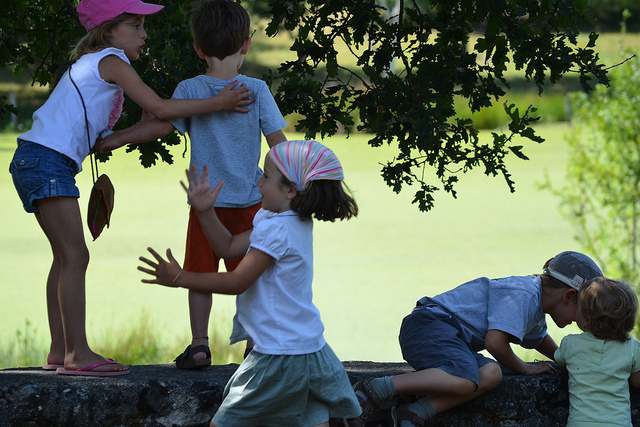As a teacher and a mom I often get asked by parents about what they should do with their kids over the summer. With an average of 11 continuous weeks in the US without academic instruction, the summer slide is a real concern.
A meta-analysis done in 1996 of 39 studies (from the early 1900s to the 1990s) concluded that students lose up to a month of grade level competency in math and reading on standardized assessments.

The analysis also showed that losses were more dramatic in math computational skills and spelling than in reading and that lower income students were at the most disadvantage – perhaps for lack of access to stimulating activities over the summer.
Rightfully concerned, many parents feel the need to drill multiplication tables with their kids when they aren’t in school. Yet parents still feel very nostalgic about their own carefree childhood summers.
Have those carefree days disappeared? Do we need to spend the summer making sure our kids’ stay competitive and don’t rot their brains?

In some instances, it is appropriate to hire a tutor or therapist or enroll your child in a specific program over the summer – there’s a reason extended school year (ESY) services exist for students with a disabilities. I’ll talk about when that’s necessary and what that looks like below.
However, many parents’ concerns are misguided – and the result is extra work and stress for both parents and kids.
Save a few trees. Ditch the workbooks.
A lot of parents think they can keep their children’s brains sharp over the summer by forcing down random math worksheets and grammar workbooks. I urge you – please don’t. Not only do these activities provide the most shallow form of learning – rote memorization of randomly chosen topics – but you’re probably doing it wrong.

While worksheets are fine tools, the educational theory behind that topic presented on a piece of paper is much more complex. In addition, education has changed significantly over the last few decades – have you ever struggled to understand your 2nd grader’s math homework?
Even I as a teacher have to constantly attend workshops, keep myself up to date on the latest research, and collaborate with colleagues to make sure I am introducing topics and supporting students in appropriate ways.
One of the reasons I developed the Ollie’s Handwriting & Phonics app was to prevent parents from teaching their children phonics sounds and handwriting incorrectly (“T says tuh!” or starting letters from the bottom). Working hard to help students unlearn bad habits is not a good use of classroom time.
Interestingly in Finland, which consistently ranks at the top in education in the world, students start formal schooling later (age 7), spend LESS time in class per day, and still have a 10 – 11 week summer break each year.
With no standardized testing, there is no easy data on summer learning loss in Finland – but it doesn’t seem to matter.
So forget the parent instituted summer homework assignments.
Instead, do what feels natural as a parent. Encourage wonder, creativity, experimentation and a quest for knowledge.

Here are my top tips for guaranteeing a summer full of fun and learning that will help your child be a stronger student – and a better person – come fall.
3 Easy ways to nurture your child’s brain
1. Read, read, read.

Read aloud to your kids – young and old.
So many people underestimate the importance of reading to their children. While bedtime stories are often a routine for preschoolers, many parents stop reading to their kids once they are able to read independently. Reading to children of all ages provides a host of cognitive and academic benefits.
Reading aloud to children instills a love of reading, sparks imagination, and helps expand children’s knowledge of the world around them. It also helps build vocabulary as well as an understanding of plot, character, themes, and writing styles.
Make it fun and more meaningful by reading with voices, acting out stories and asking lots of questions. Here are some great tips for getting the most out of reading aloud with your kids.
Encourage independent reading

Though never at the expense of shared reading with your children, encouraging or dedicating time to independent reading is also a valuable thing to do over the summer.
I have fond memories as a child and a teen of “book club” time at my family’s beach house. Late in the evening or on a rainy day, we’d all gather in the living room and just end up reading our own books independently. We’d trade books if we were interested when we were done.
Though never planned or mandated, “book club” in my childhood home encouraged me to slow down and get absorbed in a book. As the youngest of 4 children, I have always suffered greatly from FOMO. Knowing that my siblings were having fun just sitting around reading – and not off riding bikes to 7-11 for a Slurpee – made me want to join in too.
Read in front of your children

Seeing everyone in my family read taught me that reading was both something enjoyable and to be valued. While my children are currently only 2 and 4 and seem to be off to a good start with voracious appetites for books, I recently decided I wanted to do more.
During the hours my children are awake, most of my reading (and my husband’s) happens electronically on a phone – reading the news in the morning, scanning scholarly articles when I have a question, exploring nerdy topics of interests like the Fermi Paradox.
When my oldest scolded me to, “Stop working on your phone Mommy!” I realized all I’m doing is being unavailable to my children and not being the avid reader role model I thought I was. To change this – though perhaps financially and environmentally irresponsible – my husband and I signed up for Sunday deliveries of the New York Times.
I wanted to be able to enjoy my news and show my kids that yes, mommy is reading and here’s another way to do it. I’m exposing my kids to the reasons for printed material (enjoy entertaining stories and get relevant information) and modeling behavior I want to see in my own kids.
Although much more difficult, if my kids are playing independently outside and only need mild supervision, I might join them and bring along a book that I am reading. While I usually only get through a few pages of interrupted reading, it’s yet another opportunity for my kids to see me reading.
2. Parent like a scientist.

In a rapidly changing and complex world, there is no doubt that the next generation’s education should emphasize critical thinking, intrinsic motivation and creative problem solving over rote memorization. I can think of no better way to instill a love of learning and curiosity than to encourage our kids to think like scientists.
Slow down and listen
One of the easiest ways to encourage the mindset of a scientist is to slow down and listen to your kids. Schedule more time in the day to stop and examine that beetle on the sidewalk as you’re walking to the car. (We frequently have a collection in our house of dead or alive bees, flies, ladybugs, ants and cicadas that our girls love to examine.)
Point out and look at the changing shape and position of the moon. Treat every question or observation as valid and answer with more questions, guiding your children to resources to help them research the answer. Can you accurately explain why the sky is blue? I can’t.
If your child has a strong belief about something you know to be untrue, before turning them down as the omniscient adult figure in their life, help them conduct an experiment to test their hypothesis.
My daughter recently told me elephants can’t run because their feet or too big. Not the easiest experiment to run, but perhaps we’ll make a trip to the zoo and talk to the elephant keeper or find some youtube videos.
Let children conduct their own experiments
Since there is a lot of parenting advice out there – most of it conflicting and unrealistic to implement – I tend to look to nontraditional sources for inspiration. One of my favorite people to turn to is astrophysicist Neil deGrasse Tyson.
Neil believes that children are born scientists, always conducting experiments – yet parents often get in the way of their learning.
“We don’t have enough parents that understand or value the inquisitive nature of their own kids.”
If you’ve ever spent time with a young (or not so young) child, you understand they are destructive, constantly exploring the properties of objects by taking them apart and attempting to put them back together.
Neil argues that you should let kids take out the pots and pans and bang on them (an experiment in acoustics) or juggle raw eggs (a physics and biology lesson that costs less than $1). Let your child find out on her own what happens when an egg is dropped. That lesson is more powerful than any rule from a parent.
“It’s an experiment. It’s messy. Let it run it’s course.”

Challenge yourself this summer (with a little patience and some paper towels) to view your children as scientists. Before jumping in and stopping your kids’ behavior ask yourself, “Am I getting in the way of another experiment?”
Your kids might gain some valuable knowledge.
3. Provide time, space & resources to build creativity.

I am a strong believer that children learn best when learning is hands-on and inquiry-based.
Although many schools are jumping on the Maker Movement bandwagon, most traditional classrooms offer little time for students to tinker, create, innovate, problem solve and hone their passions.
‘Making’ isn’t just prepping kids for art class. It involves complex skills rooted in engineering, math, problem solving and creative thinking.
Skills that are essential for success in the economy of 2030 and beyond.
Longer days, unstructured time, and nice weather allow for more opportunities for kids to get messy and create in the summer.
Space
In order to allow your kids to fully explore their creativity, you’re going to need a little space. Again, you better start getting comfortable with disorder!
Provide your children a space where they can get messy and not have to constantly clean up. This might be outside, in the garage, or in a playroom or workshop. In our house we have a sunroom in the back with a crappy linoleum floor. We keep all of the kids art supplies and messy projects in here. While the room is organized, we don’t worry when painting gets a little out of control…

Outside we also have spaces for the girls to freely explore and mess up: a primitive fort made of sticks, a patch of dirt for digging, and a large sandbox that often turns the patio into a beach.
Resources
Although fun, kids don’t need fancy science kits to be able to tinker. They just need a collection of loose parts to explore.
Focus on providing open-ended materials and appropriate tools that children can use their imaginations to make creations. Paint, markers, glue, paper, beads, pipe cleaners, wood, clay, cardboard, sticks, rocks, chalk, water, containers, and broken electronics are all good choices.
Time
Kids can only be creative when given enough time to unplug, sit around, and do nothing. Research suggests (this study and this study) that boredom leads to greater creativity.
While it may be difficult if all adults in a household work full time over the summer, try to carve out some unstructured time in your kids’ schedule to tinker and create. An adult is of course welcome to help brainstorm ideas and support building projects, but try to step back and let kids grapple with some boredom.
The more practice children have at unstructured time, the greater their creativity muscles will grow.
Seek academic support when necessary

In many cases, consistent academic practice and support is necessary for students to retain or advance skills over the summer. In addition, academic support can help boost kids’ confidence and be ready to tackle their new classroom in the fall without experiencing the anxiety and set-backs of the previous year.
Students with learning disabilities (identified or not) often need consistent, systematic and explicit instruction to master essential phonics and math skills. While you may have heard of a child that was able to one day just pick up a book and read, the truth is that learning to read rarely just happens. The research is clear that reading is a skill that must be taught explicitly and systematically.
That child probably had lots of exposure to the rules of her language and direct instruction to enable her to one day put all the pieces together and read that book. For my students with dyslexia, learning to read requires even more targeted work. Frequent repetition and drill is important for their success.
Whether or not your child has a learning disability, if you are aware that your child is significantly behind in any academic skills, tutoring may be a wise choice over the summer. A personalized program using a child’s unique strengths to overcome specific challenges can make a big difference in a small amount of time in a child’s success in the classroom.
The goal is not to have students memorize more and more facts, but to boost confidence, drive motivation and instill a love of learning. This will naturally lead to continued progress and success in the classroom.
I work hard with my students over the summer with one major goal in mind- and it’s not a standardized academic benchmark.
I focus on bringing my student’s skills to a point where she will feel comfortable and confident in the classroom. I prepare her to handle the new demands of the next grade level as independently as possible.
Treat play as preparation for school
Lastly, don’t forget the value of play. It’s through play that children learn and hone skills such as resilience, risk-taking, confidence, social skills, emotional intelligence and curiosity.
Let them experience real life lessons and pleasures:
- testing their courage and strength by jumping from a rope swing into a lake
- igniting their senses by listening to the birds and feeling the itchy tickle of the grass as they read under a tree
- refining their social skills by joining in a group of children and collaborating to develop the rules of a made up game
While many advocate (with good reason) for a year-round schooling, I’m too nostalgic for my amazing memories of summer. I definitely encourage parents to seek out academic support when necessary, but don’t feel guilty about letting your kids enjoy summer.
Ride bikes to get ice cream, have a water balloon fight, build a tree fort. A friend and director of an amazing micro school here in Denver says it perfectly, “Childhood is a magical time that can’t be revisited.” Enjoy the magic.
Photo credits: Anne_e, Jeremy Wilburn, arvind grover, Jeremy Hiebert, Thanh Mai Bui Duy, AJ Schroetlin, woodleywonderworks, stupidmommy, Jessica Lucia

I am an E.C.E. with TDSB and am inspired by your thinking. I have a wonderful partner who is also like minded and we work in Reggio style classroom with 30 JK and SK students combined in a full day class.
I truly believe hands on does ignite their senses – so true! We have them experiment, explore in puddles, discover how caterpillars transform into butterflies and let them fly free ! They present in pairs to their classmates when they created something at sand, light table or construction, math carpet etc. as long as they had written what they created and practiced with their partner what they will present. Good dress rehearsal for presentations in the future!
I would love to continue seeing your web! Thanks for inspiring me more this summer!
Thanks Jody! Your classroom sounds like a magical place for kids and learning! Keep it up 🙂